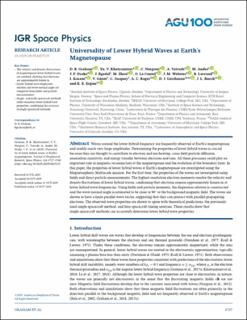| dc.contributor.author | Graham, D. B. | |
| dc.contributor.author | Khotyaintsev, Yu V | |
| dc.contributor.author | Norgren, Astrid Elisabet Cecilia | |
| dc.contributor.author | Vaivads, Andris | |
| dc.contributor.author | Andre, M. | |
| dc.contributor.author | Drake, J. F. | |
| dc.contributor.author | Egedal, J. | |
| dc.contributor.author | Zhou, M. | |
| dc.contributor.author | Le Contel, O | |
| dc.contributor.author | Webster, J.M. | |
| dc.contributor.author | Lavraud, B. | |
| dc.contributor.author | Kacem, Imed | |
| dc.contributor.author | Génot, V. | |
| dc.contributor.author | Jacquey, C. | |
| dc.contributor.author | Rager, AC | |
| dc.contributor.author | Gershman, Daniel J | |
| dc.contributor.author | Burch, J. L. | |
| dc.contributor.author | Ergun, Robert E | |
| dc.date.accessioned | 2021-07-07T08:52:46Z | |
| dc.date.available | 2021-07-07T08:52:46Z | |
| dc.date.created | 2020-02-28T21:14:48Z | |
| dc.date.issued | 2019 | |
| dc.Published | Journal of Geophysical Research (JGR): Space Physics. 2019, 124 (11), 8727-8760. | en_US |
| dc.identifier.issn | 2169-9380 | |
| dc.identifier.uri | https://hdl.handle.net/11250/2763675 | |
| dc.description.abstract | Waves around the lower hybrid frequency are frequently observed at Earth's magnetopause and readily reach very large amplitudes. Determining the properties of lower hybrid waves is crucial because they are thought to contribute to electron and ion heating, cross-field particle diffusion, anomalous resistivity, and energy transfer between electrons and ions. All these processes could play an important role in magnetic reconnection at the magnetopause and the evolution of the boundary layer. In this paper, the properties of lower hybrid waves at Earth's magnetopause are investigated using the Magnetospheric Multiscale mission. For the first time, the properties of the waves are investigated using fields and direct particle measurements. The highest-resolution electron moments resolve the velocity and density fluctuations of lower hybrid waves, confirming that electrons remain approximately frozen in at lower hybrid wave frequencies. Using fields and particle moments, the dispersion relation is constructed and the wave-normal angle is estimated to be close to 90° to the background magnetic field. The waves are shown to have a finite parallel wave vector, suggesting that they can interact with parallel propagating electrons. The observed wave properties are shown to agree with theoretical predictions, the previously used single-spacecraft method, and four-spacecraft timing analyses. These results show that single-spacecraft methods can accurately determine lower hybrid wave properties. | en_US |
| dc.language.iso | eng | en_US |
| dc.publisher | American Geophysical Union | en_US |
| dc.title | Universality of Lower Hybrid Waves at Earth's Magnetopause | en_US |
| dc.type | Journal article | en_US |
| dc.type | Peer reviewed | en_US |
| dc.description.version | publishedVersion | en_US |
| dc.rights.holder | Copyright 2019 American Geophysical Union. | en_US |
| cristin.ispublished | true | |
| cristin.fulltext | original | |
| cristin.qualitycode | 2 | |
| dc.identifier.doi | 10.1029/2019JA027155 | |
| dc.identifier.cristin | 1798575 | |
| dc.source.journal | Journal of Geophysical Research (JGR): Space Physics | en_US |
| dc.source.40 | 124 | en_US |
| dc.source.14 | 11 | en_US |
| dc.source.pagenumber | 8727-8760 | en_US |
| dc.identifier.citation | Journal of Geophysical Research (JGR): Space Physics. 2019, 124, 8727-8760. | en_US |
| dc.source.volume | 124 | en_US |
